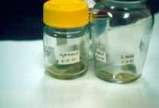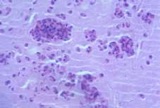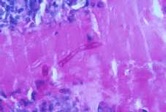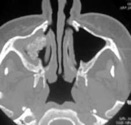Allergic fungal sinusitis

IMPORTANT The information provided is of a general nature and should not be used as a substitute for professional advice. If you think you may suffer from an allergic or other disease that requires attention, you should discuss it with your family doctor. The content of the information articles and all illustrations on this website remains the intellectual property of Dr Raymond Mullins and cannot be reproduced without written permission.
What is allergic fungal sinusitis?
Allergic fungal sinusitis is a type of sinus infection resulting from allergic inflammation in response to the presence of fungus. Treatment centres on removing affected tissue, and reducing the severity of inflammation with medication.
There are several types of fungal sinusitis
Localised infection
Invasive infection (invade surrounding soft tissue and bone)
Allergic fungal sinusitis
Allergic fungal sinusitis
In allergic fungal sinusitis, inflammation is caused by the allergic response to the fungus, rather than the infection itself. Typical symptoms of sinusitis occur, such as a blocked nose, poor sense of smell, and thick mucus coming out the nose or down the throat. Inflammation causes thickening in the lining of the sinuses, and blockage of the drainage pathways. Most patients also had nasal polyps, and inflammation involving multiple sinuses. When xrays are performed, dense white areas containing calcium are often seen (see illustrations below).
Mucus is usually dark in colour, foul smelling and very thick, a bit like cottage cheese or peanut butter. When examined, one sees the very few fungi, but lots of white cells known as eosinophils, the same type of white cells seen in allergic inflammation like asthma and hay fever.
Most people with allergic fungal sinusitis have other allergies
Most affected individuals have other allergies like asthma or hay fever. They may also have increased levels of IgE, an antibody (protein) that is often increased in people with allergies. Sometimes, a high a number of white cells in the blood known as eosinophils may occur. Usually (but not always), patients may have a positive skin prick allergy test to the involve fungus.
Treatment of allergic fungal sinusitis
Treatment involves removing affected tissue, and reducing the severity of allergic inflammation with oral steroids/cortisone tablets. Nasal corticosteroids sprays (like those used for treatment of hay fever) are frequently recommended. Most patients are advised to irrigate their nasal cavity with saline, to assist in removing thickened mucus. Since the problem results from allergic inflammation rather than infection alone, antifungal antibiotics are thought to have little role to play in this particular condition, although this is an ongoing area of research and opinions are divided as to benefit. Some studies suggest that immunotherapy injections to reduce the severity of the allergic response to fungus may also be beneficial, but this is again a controversial area where benefits of this approach are unclear and the evidence os based on case series, not controlled trials. Regular follow up removed a thickened mucosa or other material that might stop the sinuses from draining is also required.
Illustrations
The mucus in this condition is often described as having the consistency of "peanut butter". From left to right, these figures show (1). Eosinophils within mucus (2). Fungal strand seen in mucus (3). When a CT scan is performed, calcium may bee seen, showing up as extra white material (4; left side of picture).
Last reviewed 29 May 2020




References
Katzenstein, A. L., S. R. Sale, et al. (1983). "Allergic Aspergillus sinusitis: a newly recognized form of sinusitis." J Allergy Clin Immunol 72(1): 89-93.
Katzenstein, A. L., S. R. Sale, et al. (1983). "Pathologic findings in allergic aspergillus sinusitis. A newly recognized form of sinusitis." Am J Surg Pathol 7(5): 439-43.
Gourley, D. S., B. A. Whisman, et al. (1990). "Allergic Bipolaris sinusitis: clinical and immunopathologic characteristics." J Allergy Clin Immunol 85(3): 583-91.
Schwietz, L. A. and D. S. Gourley (1992). "Allergic fungal sinusitis." Allergy Proc 13(1): 3-6.
Roth, M. (1994). "Should oral steroids be the primary treatment for allergic fungal sinusitis?" Ear Nose Throat J 73(12): 928-30.
Corey, J. P., K. G. Delsupehe, et al. (1995). "Allergic fungal sinusitis: allergic, infectious, or both?" Otolaryngol Head Neck Surg 113(1): 110-9.
deShazo, R. D. and R. E. Swain (1995). "Diagnostic criteria for allergic fungal sinusitis." J Allergy Clin Immunol 96(1): 24-35.
Morpeth, J. F., N. T. Rupp, et al. (1996). "Fungal sinusitis: an update." Ann Allergy Asthma Immunol 76(2): 128-39; quiz 139-40.
Mabry, R. L. and C. S. Mabry (1997). "Immunotherapy for allergic fungal sinusitis: the second year." Otolaryngol Head Neck Surg 117(4): 367-71.
Mabry, R. L., S. C. Manning, et al. (1997). "Immunotherapy in the treatment of allergic fungal sinusitis." Otolaryngol Head Neck Surg 116(1): 31-5.
Manning, S. C., M. Merkel, et al. (1997). "Computed tomography and magnetic resonance diagnosis of allergic fungal sinusitis." Laryngoscope 107(2): 170-6.
Mabry, R. L., B. F. Marple, et al. (1998). "Immunotherapy for allergic fungal sinusitis: three years' experience." Otolaryngol Head Neck Surg 119(6): 648-51.
Schubert, M. S. and D. W. Goetz (1998). "Evaluation and treatment of allergic fungal sinusitis. II. Treatment and follow-up." J Allergy Clin Immunol 102(3): 395-402.
Schubert, M. S. and D. W. Goetz (1998). "Evaluation and treatment of allergic fungal sinusitis. I. Demographics and diagnosis." J Allergy Clin Immunol 102(3): 387-94.
Ponikau, J. U., D. A. Sherris, et al. (1999). "The diagnosis and incidence of allergic fungal sinusitis." Mayo Clin Proc 74(9): 877-84.
Dibbern, D. A., Jr. and S. C. Dreskin (2000). "Allergic fungal sinusitis." Mayo Clin Proc 75(1): 122; author reply 122-3.
Mabry, R. L. and C. S. Mabry (2000). "Allergic fungal sinusitis: the role of immunotherapy." Otolaryngol Clin North Am 33(2): 433-40.
Mabry, R. L., B. F. Marple, et al. (2000). "Outcomes after discontinuing immunotherapy for allergic fungal sinusitis." Otolaryngol Head Neck Surg 122(1): 104-6.
Schubert, M. S. (2000). "Medical treatment of allergic fungal sinusitis." Ann Allergy Asthma Immunol 85(2): 90-7; quiz 97-101.
Bassichis, B. A., B. F. Marple, et al. (2001). "Use of immunotherapy in previously treated patients with allergic fungal sinusitis." Otolaryngol Head Neck Surg 125(5): 487-90.
Schubert, M. S. (2001). "Antileukotriene therapy for allergic fungal sinusitis." J Allergy Clin Immunol 108(3): 466-7.
Marple, B., M. Newcomer, et al. (2002). "Natural history of allergic fungal rhinosinusitis: a 4- to 10-year follow-up." Otolaryngol Head Neck Surg 127(5): 361-6.
Stone, B. D. and J. J. Choi (2002). "Immunotherapy and allergic fungal sinusitis." Ann Allergy Asthma Immunol 88(5): 532; author reply 532-3
Rank MA, Adolphson CR, Kita H. Antifungal therapy for chronic rhinosinusitis: the controversy persists. Curr Opin Allergy Clin Immunol. 2009 Feb;9(1):67-72.
Schubert MS. Allergic fungal sinusitis: pathophysiology, diagnosis and management. Med Mycol. 2009;47 Suppl 1:S324-30.
Daudia A, Jones NS. Advances in management of paranasal sinus aspergillosis. J Laryngol Otol. 2008 Apr;122(4):331-5.
Schubert MS. Allergic fungal sinusitis. Clin Allergy Immunol. 2007;20:263-71.
Ryan MW, Marple BF. Allergic fungal rhinosinusitis: diagnosis and management. Curr Opin Otolaryngol Head Neck Surg. 2007 Feb;15(1):18-22.
Raz E, Win W, Hagiwara M, Lui YW, Cohen B, Fatterpekar GM. Fungal Sinusitis.
Neuroimaging Clin N Am. 2015 Nov;25(4):569-76. doi: 10.1016/j.nic.2015.07.004.
Epub 2015 Aug 21.
Dykewicz MS, Rodrigues JM, Slavin RG. Allergic fungal rhinosinusitis. J
Allergy Clin Immunol. 2018 Aug;142(2):341-351. doi: 10.1016/j.jaci.2018.06.023.